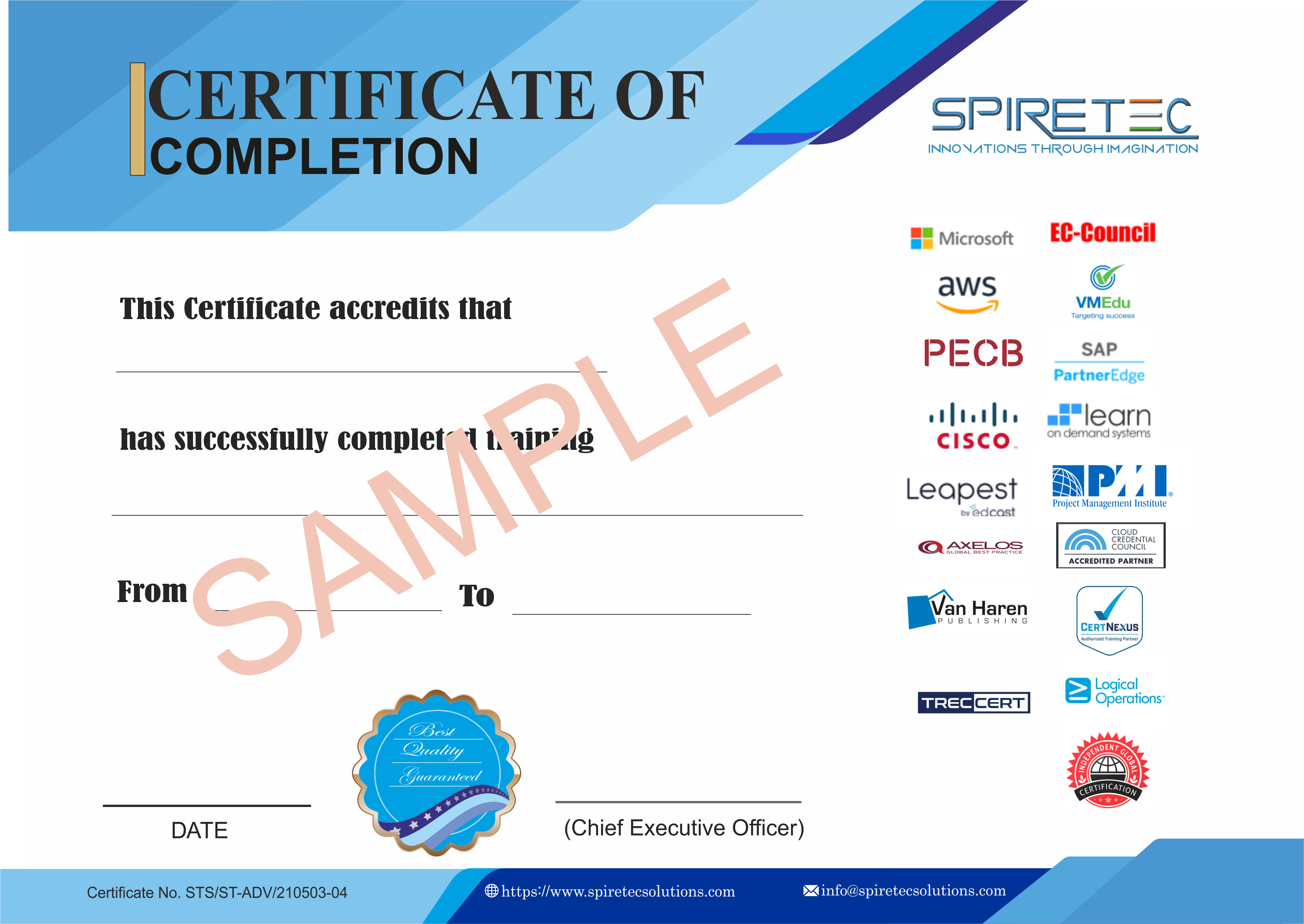Select Course
Certified Associate in Project Management (CAPM)®
Project Management Professional (PMP)®
Program Management Professional (PgMP)®
Portfolio Management Professional (PfMP)®
PMI Professional in Business Analysis (PMI-PBA)®
PMI Risk Management Professional (PMI-RMP)®
PMI Agile Certified Practitioner (PMI-ACP)®
EC-Council CEH: Certified Ethical Hacker v12
EC-Council CCT : Certified Cybersecurity Technician
EC-Council Certified Incident Handler V3
EC-Council CND: Certified Network Defender v2
EC-Council CTIA: Certified Threat Intelligence Analyst
EC-Council Certified Ethical Hacker (CEH) Master
EC-Council CCSE: Certified Cloud Security Engineer
EC-Council Certified Ethical Hacker (CEH) Practical
EC-Council CCISO: Certified Chief Information Security Officer
EC-Council CHFI: Computer Hacking Forensic Investigator v10
EC-Council ECIH : Certified Incident Handler
EC-Council CASE JAVA: Certified Application Security Engineer
CISA - Certified Information Systems Auditor
CISM - Certified Information Security Manager
CRISC - Certified in Risk and Information Systems Control
CDPSE - Certified Data Privacy Solutions Engineer
CGEIT - Certified in the Governance of Enterprise IT
CCAK - Certificate of Cloud Auditing Knowledge
COBIT 5 Foundation
COBIT 5 Implementation
CISSP - Certified Information Systems Security Professional
CCSP – Certified Cloud Security Professional
CGRC – Governance, Risk and Compliance Certification
ISSEP – Information Systems Security Engineering Professional
SSCP – Systems Security Certified Practitioner
AWS Certified Cloud Practitioner
AWS Certified Solutions Architect - Professional
AWS Certified DevOps Engineer - Professional
AWS Certified SysOps Administrator - Associate
AWS Certified Developer - Associate
AWS Certified Solutions Architect - Associate
AWS Certified Data Engineer - Associate
AWS Certified Advanced Networking - Specialty
AWS Certified Security - Specialty
Cyberyami Certified Penetration Testing Professional (C|CPTP)
Cyberyami Certified Secure Coding Expert (C|CSCE)
SAP FICO
SAP MM
SAP HR
SAP HANA
SAP Business One
SAP ABAP
SAP SuccessFactors
SAP PP
SAP HCM
SAP Healthcare
SAP BASIS
Cloud Digital Leader
Cloud Engineer
Cloud Architect
Cloud Database Engineer
Cloud Developer
Data Engineer
Cloud DevOps Engineer
Cloud Security Engineer
Cloud Network Engineer
Google Workspace Administrator
Machine Learning Engineer
Cisco Certified Network Professional (CCNP) Collaboration
Cisco Certified DevNet Associate
Cisco Certified DevNet Professional
Cisco Certified Support Technician (CCST) Networking
Cisco Certified Network Associate (CCNA)
Cisco Certified Support Technician (CCST) Cybersecurity
Cisco Certified CyberOps Associate
Cisco Certified CyberOps Professional
Cisco Certified Network Professional (CCNP) Enterprise
Cisco Certified Network Professional (CCNP) Data Center
Cisco Certified Network Professional (CCNP) Security
Cisco Certified Network Professional (CCNP) Service Provider
Cisco Certified Technician (CCT)
CompTIA A+
CompTIA Network+
CompTIA Security+
CompTIA Cloud+
CompTIA Linux+
CompTIA Server+
CompTIA CySA+
CompTIA Advanced Security Practitioner CASP+
CompTIA PenTest+
CompTIA Data+
CompTIA DataSys+
CompTIA Project+
CompTIA Cloud Essentials+
EC-Council CASE .NET: Certified Application Security Engineer
Red Hat Certified System Administrator (RHCSA)
Red Hat Certified Cloud-Native Developer
Red Hat Certified Specialist in Event-Driven Development with Kafka
Red Hat Certified Engineer (RHCE)
Red Hat Certified Enterprise Application Developer
Red Hat Certified Specialist in Cloud Infrastructure
Red Hat Certified Specialist in Deployment and Systems Management
Red Hat Certified Specialist in API Management
Red Hat Certified Specialist in Security: Linux
Red Hat Certified Specialist in Enterprise Application Server Administration
Red Hat Certified OpenShift Administrator
Red Hat Certified Specialist in High Availability Clustering
Red Hat Certified Specialist in Messaging Administration
Red Hat Certified Specialist in Cloud-native Integration
Red Hat Certified OpenShift Application Developer
Red Hat Certified Specialist in Containers
Red Hat Certified Specialist in Ansible Network Automation
Red Hat Certified Specialist in Virtualization
Red Hat Certified Specialist in OpenShift Data Foundation
ISO 9001 Quality Management System
ISO 21502 Project Management
ISO/IEC 27005 Information Security Risk Management
ISO/IEC 27033 Network Security
ISO/IEC 27035 Information Security Incident Management
ISO 22301 Business Continuity Management System
ISO 22317 Business Impact Analysis
ISO 31000 Risk Management
ISO 37301 Compliance Management System
ISO/IEC 38500 IT Governance
ISO/IEC 27701 Privacy Information Management System
ISO 13485 Medical Devices Quality Management System
ISO/IEC 17025 Laboratory Management System
ISO/IEC 20000 IT Service Management System
ISO 28000 Supply Chain Security Management System
ISO/IEC 27001 Information Security Management System
ISO/IEC 27002 Information Security Controls
ISO 45001 Occupational Health and Safety Management System
ISO 14001 Environmental Management System
ISO 22000 Food Safety Management System
ISO 50001 Energy Management System
ISO 18788 Security Operations Management System
ISO/IEC 42001 Artificial Intelligence Management System
General Data Protection Regulation (GDPR)
PRINCE2® Foundation
PRINCE2® Practitioner
PRINCE2 Agile®
MSP® Foundation
MSP® Practitioner
M_o_R® Foundation
M_o_R® Practitioner
MoP® Foundation
MoP® Practitioner
ITIL® 4 Foundation
ITIL® 4 Practitioner: Change Enablement
ITIL® 4 Practitioner: Continual Improvement
ITIL® 4 Practitioner: Release Management
ITIL® 4 Practitioner: Service Level Management
Entry Certificate in Business Analysis (ECBA)
Certification of Capability in Business Analysis (CCBA®)
Certified Business Analysis Professional (CBAP®)
Business Data Analytics Certification (IIBA®- CBDA)
Product Ownership Analysis Certification (IIBA®-CPOA)
Scrum Fundamentals Certified (SFC)
Scrum Developer Certified (SDC®)
Scrum Master Certified (SMC®)
Scrum Agile Master Certified (SAMC)
Scrum Product Owner Certified (SPOC®)
Certified SAFe® Agilist
SAFe Practice Consultant
Certified SAFe® Product Owner/Product Manager
Certified SAFe® Scrum Master
Certified SAFe® Lean Portfolio Manager
Certified SAFe® Advanced Scrum Master
Certified SAFe® DevOps Practitioner
Certified SAFe® Architect
Certified SAFe® Agile Product Manager
Six Sigma Yellow Belt Certification CSSYB
Six Sigma Green Belt Certification CSSGB
Six Sigma Black Belt Certification CSSBB
Microsoft Project 2019
TOGAF® 9
TOGAF® Business Architecture Foundation
TOGAF® Enterprise Architecture Bridge
AI - 102 : Designing and Implementing an Azure AI Solution
AI - 900 : Microsoft Azure AI Fundamentals
AZ - 1004 : Deploy and configure Azure Monitor
AZ - 104 : Microsoft Azure Administrator
AZ - 2001 : Implement Security through a Pipeline using Azure DevOps
AZ - 2002 : Develop an ASP.NET Core web app that consumes an API
AZ - 2003 : Deploy cloud-native apps using Azure Container Apps
AZ - 204 : Developing Solutions for Microsoft Azure
AZ - 400 : Microsoft Azure DevOps Engineer
AZ - 500 : Microsoft Azure Security Technologies
AZ - 801 : Configuring Windows Server Hybrid Advanced Services
AZ - 900 : Microsoft Azure Fundamentals
DP - 300 : Azure Database Administrator Associate
DP - 900 : Microsoft Azure Data Fundamentals
MB - 300 : Microsoft Dynamics 365: Core Finance and Operations
MB - 335 : Microsoft Dynamics 365 Supply Chain Management, Expert
MB - 500 : Microsoft Dynamics 365: Finance and Operations Apps Developer
MS - 203 : Microsoft 365 Messaging
MS - 900 : Microsoft 365 Fundamentals
PL - 500 : Microsoft Power Automate RPA Developer
AZ - 220 : Microsoft Azure IoT Developer
MB - 220 : Configure settings and core functionality in Dynamics 365 for Marketing
MB - 220 : Microsoft Dynamics 365 Marketing
MB - 220 : Set up events and surveys in Dynamics 365 for Marketing
MB - 230 : Microsoft Dynamics 365 Customer Service
MB - 240 : Microsoft Dynamics 365 Field Service
MB - 310 : Microsoft Dynamics 365 Finance
MB - 330 : Microsoft Dynamics 365 Supply Chain Management
MB - 700 : Microsoft Dynamics 365: Finance and Operations Apps Solution Architect
MS - 700 : Managing Microsoft Teams
MS - 900 : Microsoft Dynamics 365 Fundamentals
PL - 100 : Microsoft Power Platform App Maker
PL - 200 : Microsoft Power Platform Functional Consultant
PL - 400 : Microsoft Power Platform Developer
PL - 900 : Microsoft Power Platform Fundamentals
AZ - 1401 : Planning and Administering Microsoft Azure for SAP Workloads
SC - 200 : Microsoft Security Operations Analyst
SC - 300 : Microsoft Identity and Access Administrator
SC - 900 : Microsoft Security, Compliance, and Identity Fundamentals
AZ - 040T00 : Automating Administration with PowerShell
AZ - 305 : Designing Microsoft Azure Infrastructure Solutions
AZ - 700 : Designing and Implementing Microsoft Azure Networking Solutions
AZ - 800 : Administering Windows Server Hybrid Core Infrastructure
AZ - 1402 : Configuring and Operating Windows Virtual Desktop on Microsoft Azure
DP - 203T00 : Data Engineering on Microsoft Azure
DP - 100T01 : Designing and Implementing a Data Science Solution on Azure
AI - 103 : Develop Generative AI Solutions with Azure Open AI Service
DP - 420 : Azure Cosmos DB Developer Specialty
MB - 260T00 : Microsoft Customer Insights - Data Specialty
MB - 800T00 : Microsoft Dynamics 365 Business Central Functional Consultant
MB - 910T00 : Microsoft Dynamics 365 Fundamentals (CRM)
MB - 920T00 : Microsoft Dynamics 365 Fundamentals (ERP)
MB - 210T01 : Microsoft Dynamics 365 Sales
PL - 600T00 : Microsoft Power Platform Solution Architect
MS - 721 : Microsoft Teams Voice Engineer
PL - 300 : Power BI Data Analyst Associate
SC - 100 : Microsoft Cybersecurity Architect
SC - 400 : Microsoft Information Protection Administrator Associate
MS - 4001 : Build collaborative apps for Microsoft Teams
AZ - 1002 : Configure secure access to your workloads using Azure virtual networking
SC - 5001 : Configure SIEM security operations using Microsoft Sentinel
AI - 3004 : Create computer vision solutions with Azure AI Vision
AZ - 1001 : Deploy containers by using Azure Kubernetes Service (AKS)
AI - 3003 : Develop natural language processing solutions with Azure AI Services
AI - 3002 : Develop solutions with Azure AI Document Intelligence
DP - 604T00 : Implement a data science and machine learning solution for AI in Microsoft Fabric
DP - 602T00 : Implement a data warehouse with Microsoft Fabric
MF - 3001 : Implement Real-Time Analytics with Microsoft Fabric
MD - 102 : Microsoft 365 Endpoint Administrator
DP - 600T00 : Microsoft Fabric Analytics Engineer
DP - 3001 : Migrate SQL Server workloads to Azure SQL
MS - 102 : Microsoft 365 Administrator
PL - 7001 : Create and manage canvas apps with Power Apps
PL - 7002 : Create and Manage Automated Processes by using Power Automate
PL - 7003 : Create and manage model-driven apps with Power Apps and Dataverse
AZ - 1003 : Secure storage for Azure Files and Azure Blob Storage
DP - 3007 : Train and deploy a machine learning model with Azure Machine Learning
DP - 601 : Implement a Lakehouse with Microsoft Fabric
SC - 5003 : Implement information protection and data loss prevention by using Microsoft Purview
SC - 5002 : Secure Azure services and workloads with Microsoft Defender for Cloud regulatory compliance controls
VMware HCX : Deploy, Configure, Manage
VMware Site Recovery Manager : Install, Configure, Manage (V8.6)
VMware Aria Automation : Orchestration and Extensibility (V8.13)
VMware vSAN : Troubleshooting (V8)
VMware Aria Automation : Advanced Topics (v8.14)
VMware Cloud Foundation : Deploy, Configure, Manage (V5.0)
VMware vSphere : Design (V8)
VMware Cloud Director : Advanced Networking with NSX-T Data Center (V10.2)
VMware Cloud Director : Advanced Workshop (V10.2)
VMware Cloud Director : Install, Configure, Manage (V10.4)
VMware NSX Advanced Load Balancer : Web Application Firewall Security
VMware NSX Advanced Load Balancer : Infrastructure and Application Automation
VMware NSX Advanced Load Balancer : Global Server Load Balancing Design and Deploy
VMware NSX Advanced Load Balancer : Install, Configure, Manage (V21.x)
VMware NSX Advanced Load Balancer : Install, Configure, Manage (V20.x)
VMware vSphere with Tanzu : Deploy, Configure, Manage (V8)
VMware Tanzu Kubernetes Grid : Install, Configure, Manage (V2.0)
VMware vSphere with Tanzu : Deploy and Manage (V7)
VMware Horizon : Deploy and Manage (V8.8)
VMware Workspace ONE : Advanced Integrations (V22.x)
VMware Workspace ONE : UEM Troubleshooting (V22.x)
VMware Workspace ONE : UEM Bootcamp (V22.x)
VMware Workspace ONE : Skills for UEM (V22.x)
VMware Workspace ONE : Integrations (V22.x)
VMware Workspace ONE : Deploy and Manage (V22.x)
VMware Horizon 8 : Deploy and Manage plus App Volumes Fast Track
VMware Carbon Black EDR Advanced Analyst
VMware Carbon Black EDR Advanced Administrator
VMware Carbon Black Cloud : Advanced Operations and Troubleshooting
VMware Carbon Black App Control Advanced Administrator
VMware Carbon Black Cloud : Plan and Deploy
VMware vRealize Operations for Operators (V8.6)
VMware NSX : Design (V4)
VMware vSphere : Operate, Scale and Secure (V8)
55215 : SharePoint Online Power User
55216 : SharePoint 2013 Power User
55217 : SharePoint 2016 Power User
55238 : SharePoint Online for Administrators
55265 : Microsoft Power Apps Super User
55268 : Microsoft Power Automate for End Users
55281 : SharePoint Online Branding
55283 : Microsoft Office 365 Power User
55286 : SharePoint 2019 Power User
55300 : Microsoft Teams for End Users
55302 : Microsoft Lists for End Users
55304 : Microsoft Dataverse for Teams
55311 : SharePoint Server SE for Power Users
55355 : SharePoint 2016 Administration
55400 : Microsoft Power BI for End Users
55485 - Microsoft 365 Copilot Super User
M55342B : Supporting and Troubleshooting Windows 11
M55371A : Windows Server Administration
M55348B : Administering Microsoft Configuration Manager
M55339A : Programming in C#
M55337A : Introduction to Programming
M55354A : Administering Office 365
M55399B : Implementing and Managing Microsoft Intune
M55353A : Administering a SQL Database Infrastructure
M55344A : Identity with Windows Server
M55345B : Implementing and Managing Windows 11
M55341B : Installation, Storage, and Compute with Windows Server
M55372A : Microsoft Azure Advanced Administration
M55343A : Networking with Windows Server
M55340A : Developing ASP.NET Core Web Applications
M55370A : SharePoint Online Management and Administration
M55352A : Introduction to SQL Databases
M55616A : Microsoft Copilot Overview for IT Professionals
M55610A : Planning and Implementing Microsoft Sentinel (SIEM & SOAR)
M98367A : Microsoft Security Foundations
M55408A : Office 365 Administration and Troubleshooting
M55615A : Deploying and Managing Windows 11 with Microsoft Configuration Manager and Intune
M55604A : Using AI and Copilot in the Microsoft Power Platform
M55618A : Microsoft Copilot for Microsoft 365 for End Users
M55613A : Advanced Web Development
M55617A : Introduction to Windows 11 for IT Professionals
M55622A : Azure Administration for AWS Sysops
M55626A : Advanced Administration and Automation with PowerShell
M98366A : Microsoft Networking Foundations
M98349A : Microsoft Operating System Foundations
AI - 3016 : Develop Custom Copilots with Azure AI Studio
AI - 3018 : Copilot Foundations
MS - 4004 : Empower your workforce with Copilot for Microsoft 365 Use Cases
MS - 4005 : Craft effective prompts for Microsoft Copilot for Microsoft 365
MS - 4006 : Copilot for Microsoft 365 for Administrators
MS - 4009 : Extend Microsoft Copilot for Microsoft 365 with Copilot Studio
MS - 4010 : Build Plugins and Connectors for Microsoft Copilot for Microsoft 365
MS - 4012 : Microsoft Copilot Web Based Interactive Experience for Executives
PL - 7008 : Create and extend custom copilots in Microsoft Copilot Studio
AZ - 1010 : Deploy and Manage Azure Arc-enabled Servers
Cognicert - Auditing and Internal Control Professional
Cognicert - Bank Operations Managers Course
Cognicert - Business Continuity & Resilience Manager Course
Cognicert - Inspection Manager Course
ISO 14064 - Green House Gas Lead Auditor Course
ISO 42001 - Artificial Intelligence Management System Lead Implementer Course
Cognicert - HACCP Lead Assessor Course
ISO 3834 - Fusion Welding Quality Lead Auditor Course
Cognicert - ISO 7101 Healthcare Quality Lead Auditor Course
ISO 9001 : 2015 - Quality Management System
Cognicert - ISO 14298 Security Printing Lead Auditor Course
Cognicert - ISO 17024 Personnel Certification Body Lead Assessor Course
Cognicert - ISO 17065 Product Certification Lead Assessor Course
ISO 18788 - Security Operations Lead Auditor Course
ISO 20252 Research Services Lead Auditor Course
Cognicert - ISO 20387 Bio Banking Lead Assessor Course
Cognicert - ISO 20387 Bio Banking Lead Implementer Course
Cognicert - ISO 22000: 2018 Food Safety Management Systems (FSMS)
ISO 26000 - Lead Implementer Course
Cloud Computing
Cyber Security Professional
C/C++ Language
Full Stack Web Develeopment
Data Analysis (Advance Excel/Power BI /Tableau)
Java
Stock Market
Digital Marketing
ISO/IEC 27001 Lead Auditor
ISO/IEC 27001 Foundation
ISO/IEC 42001 Lead Implementer
ISO/IEC 42001 Lead Auditor
ISO 14001 Lead Implementer
ISO 14001 Lead Auditor
ISO 37301 Lead Implementer
ISO 37301 Lead Auditor
ISO 22301 Lead Implementer
ISO 22301 Lead Auditor
Data Protection Essentials
GDPR Professional
ISO 37001 Lead Auditor
ISO 37001 Lead Implementer
ISO 37000 Lead Auditor
Lead Cloud Security Manager
Certified Cyber Threat Analyst (CCTA)
GH - 300T00 : GitHub Copilot
GH - 500T00 : GitHub Advanced Security
GH - 900T00 : GitHub Foundations
DP - 600T00 : Microsoft Fabric Analytics Engineer
DP - 601T00 : Implement a Lakehouse with Microsoft Fabric
DP - 602T00 : Implement a Data Warehouse with Microsoft Fabric
DP - 603T00 : Implement Real-Time Intelligence with Microsoft Fabric
DP - 604T00 : Implement a data science and machine learning solution for AI with Microsoft Fabric
DP - 700T00 : Microsoft Fabric Data Engineer
SC - 401T00 : Information Security Administrator
CC - Certified in Cybersecurity
CISSP-ISSAP - Information Systems Security Architecture Professional
CISSP-ISSMP - Information Systems Security Management Professional
CSSLP - Certified Secure Software Lifecycle Professional
AZ-2006: Automate Azure Load Testing by using GitHub Actions
AZ-2007: Accelerate app development by using GitHub Copilot
MD-4011: Enhance Endpoint Security with Microsoft Intune and Microsoft Copilot for Security
MS-4002: Prepare security and compliance to support Microsoft 365 Copilot
MS-4007: Microsoft 365 Copilot User Enablement Specialist
MS-4008: Microsoft 365 Copilot Interactive Experience for Executives
MS-4014: Build a foundation to build AI agents and extend Microsoft 365 Copilot
MS-4017: Manage and extend Microsoft 365 Copilot
MS-4021: Copilot Immersion Experience
SC-5006: Enhance security operations by using Microsoft Security Copilot
GH-100T00: GitHub fundamentals - Administration basics and product features
DP-605T00: Prepare and visualize data with Microsoft Power BI
AZ-500T00: Microsoft Azure Security Technologies
SC-5004: Defend against cyberthreats with Microsoft Defender XDR
SC-5007: Implement retention, eDiscovery, and Communication compliance in Microsoft Purview
SC-5008: Configure and govern entitlement with Microsoft Entra ID
AI-3017: AI for business leaders
AI-3019: Build AI Apps with Azure Database for PostgreSQL
AI-3022: Implement knowledge mining with Azure AI Search
AI-3026: Develop AI agents on Azure
AZ-1006: Migrate and Modernize SAP in the Microsoft Cloud
AZ-1007: Deploy and administer Linux virtual machines on Azure
AZ-1008: Administer Active Directory Domain Services
AZ-120T00: Planning and Deploying SAP on Azure
AZ-2005: Develop Generative AI solutions using Azure OpenAI and the Semantic Kernel SDK
AZ-2008: DevOps Foundations: The Core Principles and Practices
AZ-2010: Designing and Implementing Platform Engineering
DP-3011: Implementing a Data Analytics Solution with Azure Databricks
DP-3012: Implementing a Data Analytics Solution with Azure Synapse Analytics
DP-3014: Implementing a Machine Learning solution with Azure Databricks
DP-3020: Develop data-driven applications with Azure SQL Database
DP-3021: Configure and migrate to Azure Database for PostgreSQL







 Live Online Training (Duration : 40 Hours)
Live Online Training (Duration : 40 Hours)
